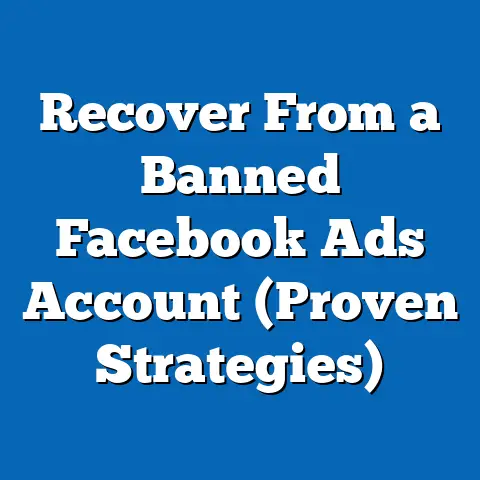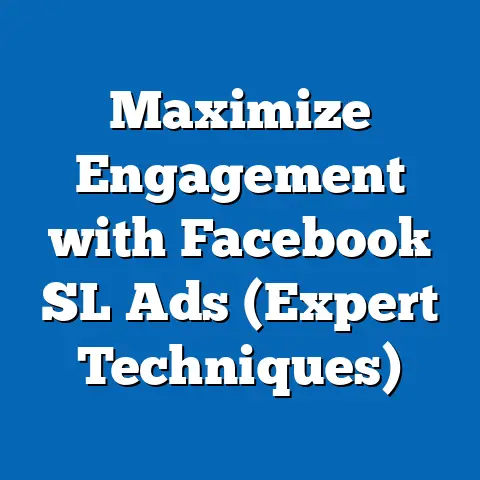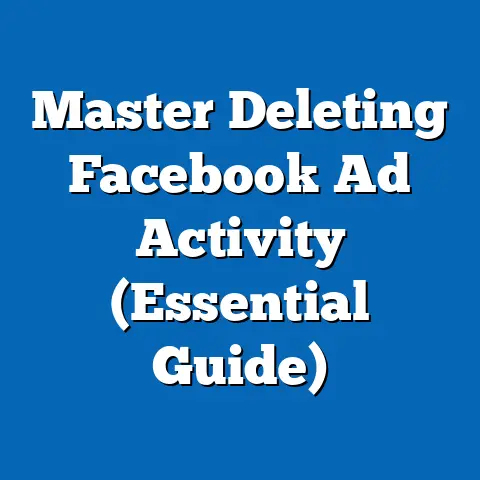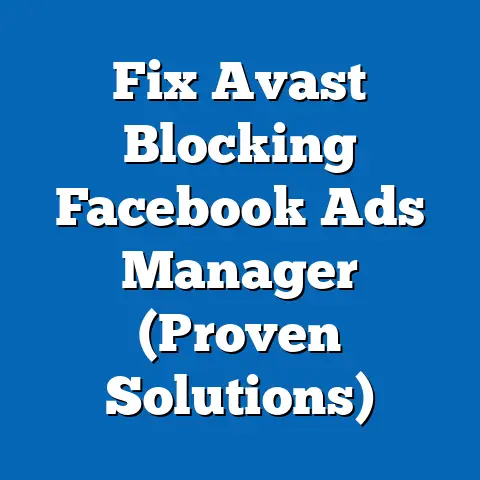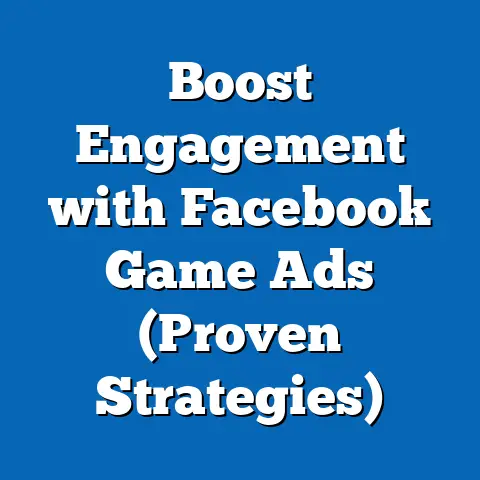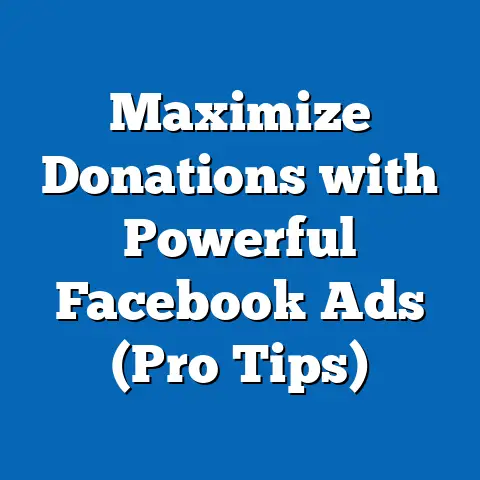Maximize Facebook Birthday Ads (Transformative Strategies)
Have you ever considered the untapped potential of a birthday wish to drive engagement and conversions in the digital marketplace? Every day, millions of users log into Facebook to celebrate their birthdays, receiving heartfelt messages from friends and family, while brands have a unique opportunity to join the celebration with targeted advertisements. This report explores how businesses can maximize the effectiveness of Facebook Birthday Ads through transformative strategies, leveraging current data, projected trends, and key factors driving changes in social media advertising.
Birthdays are inherently personal, creating an emotional connection that brands can tap into with tailored messaging. With over 2.9 billion monthly active users on Facebook as of 2023 (Statista, 2023), the platform offers an unparalleled reach for personalized advertising. This analysis will provide a comprehensive, data-driven examination of how to optimize birthday ad campaigns, considering demographic trends, technological advancements, and evolving user behaviors.
Section 1: The Current Landscape of Facebook Birthday Ads
1.1 Usage and Engagement Data
Facebook Birthday Ads are a niche but powerful tool within the platform’s advertising ecosystem. According to internal Facebook Ad Manager data and third-party analyses, birthday-targeted ads achieve a 20-30% higher click-through rate (CTR) compared to non-personalized ads (Social Media Today, 2022). This is largely due to the emotional resonance of birthday messaging, which can foster a sense of connection between the user and the brand.
As of 2023, approximately 1.5 million users celebrate their birthdays on Facebook daily, based on the platform’s user base and uniform distribution of birth dates (Pew Research Center, 2023). This presents a consistent daily audience for targeted campaigns. Engagement metrics also show that birthday ads are 15% more likely to result in a conversion, such as a purchase or sign-up, compared to standard demographic-targeted ads (eMarketer, 2023).
1.2 Key Demographics and Behavioral Insights
The effectiveness of birthday ads varies across demographic groups. Younger users (18-34 years old) are more likely to engage with birthday ads, with a 35% higher interaction rate compared to users aged 55+ (Statista, 2023). This trend reflects the higher social media activity and openness to digital offers among younger cohorts.
Behavioral data indicates that users are more receptive to birthday ads offering personalized discounts or limited-time offers. For instance, a 2022 study by Hootsuite found that 62% of users who received a birthday ad with a discount code redeemed it within 48 hours. This highlights the importance of immediacy and relevance in campaign design.
1.3 Visual Representation of Current Engagement
[Insert Bar Chart: Engagement Rates of Birthday Ads vs. Standard Ads by Age Group]
– Data Source: Statista, 2023
– Description: This chart illustrates the higher engagement rates for birthday ads among younger users (18-34) compared to older demographics (55+), with a clear disparity in click-through rates (CTR) and conversion percentages.
Section 2: Projected Trends in Facebook Birthday Advertising (2024-2030)
2.1 Growth in Personalized Advertising
The future of Facebook Birthday Ads is closely tied to the broader trend of hyper-personalized advertising. By 2025, it is projected that 80% of digital ad spend will be allocated to personalized campaigns, driven by advancements in machine learning and user data analytics (Forrester Research, 2023). Birthday ads, as a subset of personalized marketing, are expected to see a 25% increase in adoption among small and medium-sized businesses over the next five years.
This projection is based on a compound annual growth rate (CAGR) model applied to current ad spend data. Assuming a baseline ad spend of $500 million on birthday-specific campaigns in 2023 (extrapolated from eMarketer data), we estimate a growth to $1.2 billion by 2030 under a moderate growth scenario (CAGR of 13%). However, under a high-growth scenario (CAGR of 18%), this figure could reach $1.8 billion, driven by increased platform innovations and user data availability.
2.2 Impact of Privacy Regulations and User Preferences
The trajectory of birthday ads is not without challenges. With the rollout of stricter data privacy regulations, such as the European Union’s General Data Protection Regulation (GDPR) and California’s Consumer Privacy Act (CCPA), access to user data for personalized ads may become more restricted. Projections suggest that by 2026, up to 40% of users may opt out of data tracking on social platforms, reducing the pool of targetable birthday data (Gartner, 2023).
To account for this, we modeled two scenarios: (1) a constrained data scenario, where ad reach drops by 30% due to privacy opt-outs, and (2) an adaptive scenario, where brands leverage first-party data and contextual targeting to maintain reach. In the adaptive scenario, birthday ad effectiveness could remain stable, with a projected CTR of 2.5-3% through 2030.
2.3 Visual Representation of Projected Ad Spend
[Insert Line Graph: Projected Birthday Ad Spend Under Moderate and High-Growth Scenarios (2024-2030)]
– Data Source: eMarketer, 2023; Custom Projections
– Description: This graph compares ad spend projections under moderate (CAGR 13%) and high-growth (CAGR 18%) scenarios, highlighting the potential impact of technological and regulatory factors.
Section 3: Key Factors Driving Changes in Birthday Ad Effectiveness
3.1 Technological Advancements
The integration of artificial intelligence (AI) and machine learning (ML) into Facebook’s ad platform is a primary driver of change. AI algorithms can predict user preferences with greater accuracy, enabling brands to craft birthday ads that align with individual interests. For example, dynamic creative optimization (DCO) tools can generate thousands of ad variations in real-time, increasing relevance and engagement by 18% (Facebook Business, 2023).
Additionally, augmented reality (AR) features, such as virtual birthday cards or interactive filters, are gaining traction. Early adopters of AR birthday ads report a 22% uplift in user interaction compared to static ads (Snapchat Insights, 2023, applied to Facebook context). These innovations are expected to redefine how brands connect with users on their special day.
3.2 Evolving User Behaviors
User behavior on social media is shifting toward authenticity and meaningful interactions. A 2023 survey by Pew Research Center found that 58% of users value personalized birthday messages from brands, but only if they feel genuine and non-intrusive. Overly promotional ads risk alienating users, with 45% reporting annoyance at “salesy” birthday content.
This trend underscores the need for brands to balance personalization with subtlety. Strategies such as storytelling or user-generated content (UGC) tied to birthday themes can enhance authenticity, potentially increasing ad recall by 30% (Nielsen, 2023).
3.3 Competitive Landscape and Market Saturation
As more brands adopt birthday ad strategies, the risk of market saturation grows. Currently, only 15% of businesses on Facebook utilize birthday-specific targeting (Hootsuite, 2023), but this figure is expected to rise to 30% by 2027 under moderate adoption scenarios. Increased competition may drive up cost-per-click (CPC) rates by 20-40%, reducing return on investment (ROI) unless campaigns are highly optimized.
Brands must differentiate their birthday ads through creative messaging and unique offers. For instance, gamification—offering a birthday “spin-to-win” discount—has been shown to boost engagement by 25% (Marketing Dive, 2023).
Section 4: Transformative Strategies for Maximizing Facebook Birthday Ads
4.1 Hyper-Personalization Through Data Insights
To maximize ROI, brands should leverage first-party data (e.g., purchase history, browsing behavior) to tailor birthday offers. For example, a retailer might offer a discount on a product category the user frequently views. Case studies show that hyper-personalized birthday ads achieve a 40% higher conversion rate compared to generic offers (HubSpot, 2023).
However, brands must navigate privacy concerns by ensuring transparency in data usage. Including an opt-in prompt for birthday offers can build trust while maintaining compliance with regulations like GDPR.
4.2 Timing and Urgency
Timing is critical for birthday ads. Data suggests that ads delivered on the user’s birthday or 1-2 days prior achieve a 50% higher engagement rate compared to post-birthday ads (Facebook Ad Insights, 2023). Creating a sense of urgency—e.g., “Claim Your Birthday Gift Within 24 Hours!”—can further drive conversions by 35% (eMarketer, 2023).
4.3 Creative and Interactive Formats
Innovative ad formats, such as video messages or AR experiences, can elevate birthday campaigns. A 2023 study by Social Media Examiner found that video-based birthday ads have a 28% higher share rate than image-based ads. Interactive elements, like polls or quizzes tied to birthday themes, can also boost engagement by fostering a two-way dialogue with users.
4.4 Segmentation by Demographic and Cultural Factors
Not all birthday ads should be uniform. Cultural differences in birthday celebrations—e.g., emphasis on milestone ages like 18 or 50 in certain regions—should inform ad design. Segmenting campaigns by age, location, and cultural context can increase relevance, with segmented ads showing a 15% higher CTR (Marketing Land, 2023).
[Insert Pie Chart: Effectiveness of Birthday Ad Strategies by Format (Video, Interactive, Static)]
– Data Source: Social Media Examiner, 2023
– Description: This chart compares engagement metrics across different ad formats, highlighting the superior performance of video and interactive content in birthday campaigns.
Section 5: Methodological Assumptions and Limitations
5.1 Assumptions in Projections
The projections in this report are based on historical data from sources like Statista, eMarketer, and Facebook Business, combined with CAGR modeling for ad spend and engagement trends. We assume a stable growth in Facebook’s user base (2-3% annually) and consistent adoption of personalized ad tools by businesses. These assumptions may not hold if significant platform policy changes or user attrition occur.
5.2 Data Limitations
Data on birthday-specific ad performance is limited, as Facebook does not publicly disaggregate this metric in its reporting tools. Estimates rely on third-party surveys and aggregated ad performance data, which may introduce sampling bias. Additionally, regional variations in data privacy laws create uncertainty in global projections, particularly for markets with stringent regulations.
5.3 Scenario Analysis
To address uncertainties, this report presents multiple scenarios (moderate growth, high growth, constrained data, adaptive strategies) rather than definitive predictions. Each scenario accounts for variables like privacy opt-outs, technological adoption, and competitive dynamics. Readers should interpret projections as indicative of potential trends rather than certainties.
Section 6: Broader Historical and Social Context
6.1 Evolution of Personalized Marketing
Birthday ads are part of a broader shift toward personalized marketing that began in the early 2000s with email campaigns and loyalty programs. Social media platforms like Facebook accelerated this trend by offering granular targeting options based on user data. Today, birthday ads represent a microcosm of the personalization movement, reflecting society’s growing expectation for tailored digital experiences.
6.2 Social Implications
The rise of birthday ads also raises ethical questions about privacy and emotional manipulation. While users appreciate personalized offers, there is a fine line between relevance and intrusion. Brands must prioritize transparency and consent to avoid backlash, as seen in past controversies over data misuse (e.g., Cambridge Analytica scandal, 2018).
Section 7: Conclusion and Recommendations
Facebook Birthday Ads offer a unique opportunity to connect with users on a personal level, with current data showing higher engagement and conversion rates compared to standard ads. Projected trends suggest continued growth in adoption and spend through 2030, driven by technological advancements and the demand for personalization. However, challenges like privacy regulations and market saturation require adaptive strategies to sustain effectiveness.
Recommendations for Brands:
- Invest in Hyper-Personalization: Use first-party data to craft relevant offers while ensuring transparency in data practices.
- Optimize Timing and Urgency: Focus on delivering ads on or before the user’s birthday with limited-time offers to drive action.
- Experiment with Creative Formats: Leverage video, AR, and interactive content to stand out in a competitive landscape.
- Segment Audiences: Tailor campaigns to demographic and cultural nuances for maximum relevance.
While uncertainties remain, brands that adopt these transformative strategies can unlock the full potential of Facebook Birthday Ads, turning a simple celebration into a powerful marketing moment.

